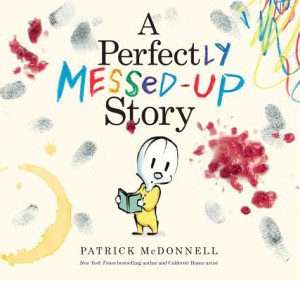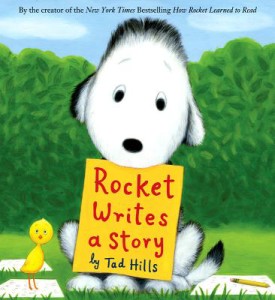Rufus the Writer, by Elizabeth Bram, illustrated by Chuck Groenink (Schwartz & Wade, 2015)
Laying on the grass, watching the clouds one day, Rufus gets an idea. “I’m not going to have a lemonade stand this summer… I’m going to have a story stand!” Rufus brings pencils, paper, and markers and waits for his first customers.
It isn’t long before Millie and Walter arrive. They want a story! Rufus promises one in exchange for a special shell from the beach. The two friends head off and Rufus writes “Orange is the Best Color.” It’s imaginative and creative and exactly the kind of story you might expect from a budding writer.
More friends come, of course. Which means more stories from Rufus. Stories that will help young students understand that no special formula is needed. Ideas for stories are everywhere!

A Perfectly Messed-Up Story by Patrick McDonnell (Little Brown and Company, 2014)
One of the hardest things for young kids to grasp is the idea that stories don’t have to be perfect on the first go. A mistake here, a redo there. Stories need to be messed with.
Yes, this book is a bit quirky. Yes, also, it’s hard to see all those smudges and “jelly stains” on the pages. But it does make a good point that I think kids and teachers can appreciate. Embrace the messiness and keep going. The best stories are those that have been fiddled with – worked through and through long enough to make it past the hard, messy parts and all the way to… THE END.

Rocket Writes a Story by Tad Hills (Schwartz & Wade, 2012)
Rocket loves books. He also loves words and enjoys collecting his favorites to bring to the little yellow bird who is his teacher. All those splendid words! What should he do with them? Write a story, of course. But, poor Rocket. He suffers from the same problem many kids do. “I don’t know what to write,” he tells his teacher. “Don’t worry,” she says.
Rocket takes a long walk looking for inspiration. He thinks about his friends and notices a beautiful pine tree. He sticks his nose in the air, sniffing the gentle breeze. Before long, he happens upon something truly lovely. A rustling in the branches high above. An owl! Rocket loves her friendly face and her big round eyes.
As Rocket begins to notice the many small details he’d missed, a story starts to grow. A wonderful story about a brave, but shy owl who becomes Rocket’s friend.
Don’t miss this lovely book about yet another way to find stories. And, for an extra treat, pair this book with How Rocket Learned to Read, also by Tad Hills.











Hi Dianne,
Thanks for selecting these stories about writing. I particularly agree with your statements about how important it is for kids to see that stories need work, like building a sand castle at the beach. I kept everything from my first draft of Ringle Tingle Tiger right through to the final version(20 drafts) as well as tracking 5 different versions of the cover.
When I visited schools I showed slides of these versions just to reinforce your point-First work is not best work(though it can have some brilliant bits).
Congratulations on having your first children’s book published last year.
Best wishes
Mark Johnson Austin
I agree that revision is such a big part of the writing process, Mark. It’s fascinating to track the changes/history of one manuscript. It’s all about stamina and hard work! Thanks for stopping by ReaderKidZ!
Dianne